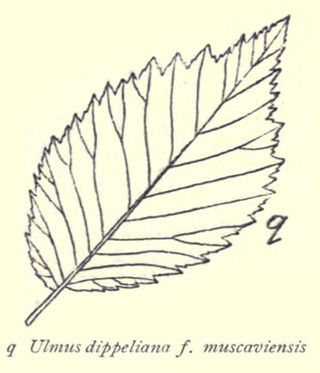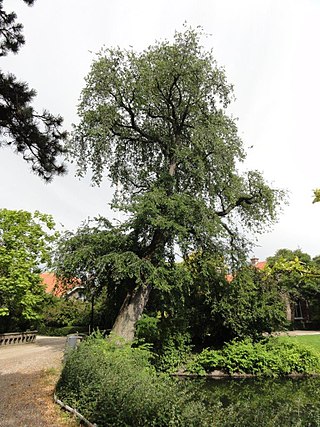Related Research Articles
The elm cultivar Ulmus 'Atropurpurea' [:dark purple] was raised from seed at the Späth nursery in Berlin, Germany, circa 1881, as Ulmus montana atropurpurea, and was marketed there till the 1930s, being later classed as a cultivar by Boom. Henry (1913) included it under Ulmus montana cultivars but noted that it was "very similar to and perhaps identical with" Ulmus purpureaHort. At Kew it was renamed U. glabraHuds. 'Atropurpurea', but Späth used U. montana both for wych elm and for some U. × hollandica hybrids, so his name does not necessarily imply a wych elm cultivar. The Hesse Nursery of Weener, Germany, however, which marketed 'Atropurpurea' in the 1950s, listed it in later years as a form of U. glabraHuds..

The putative hybrid cultivar Ulmus × hollandica 'Serpentina' is an elm of unknown provenance and doubtful status. Henry identified it as intermediate between U. glabra and U. minor, a view accepted by Bean and by Melville, who believed that the specimens at Kew bearing the name 'Serpentina' were U. glabra "introgressed by U. carpinifolia" [: U. minor] and were similar to but "distinct from 'Camperdownii'".

The Field Elm cultivar Ulmus minor 'Propendens', described by Schneider in 1904 as U. glabra (:minor) var. suberosa propendens, Weeping Cork-barked elm, was said by Krüssmann (1976) to be synonymous with the U. suberosa pendula listed by Lavallée without description in 1877. Earlier still, Loudon's Arboretum et Fruticetum Britannicum had included an illustration of a pendulous "cork-barked field elm", U. campestris suberosa. An U. campestris suberosa pendula was in nurseries by the 1870s.
The elm cultivar Ulmus 'Monstrosa' [: "monstrous", "strange"], a shrub-elm with fasciated branching, is believed to have originated in France, where it was first listed by Lavallée in Arboretum Segrezianum (1877) as a form of Field Elm, Ulmus campestris var. monstrosa, but without description. Though its long slender 2 cm petiole is not a feature of wych elm U. glabraHuds., and is even less likely in a shrub form of this species, the wych-cultivar error arose early, perhaps because the Späth nursery of Berlin, using Ulmus montana both for some Ulmus × hollandica cultivars and for wych varieties, listed it c.1890 as Ulmus montana monstrosa. Hartwig in Illustrirtes Gehölzbuch (1892) followed with Ulmus scabra monstrosa, an error repeated by Krüssman (1962) and by Green (1964), with their U. glabraHuds. 'Monstrosa'.
The Wych Elm cultivar Ulmus glabra 'Albo-Variegata' was first mentioned by Weston in 1770 as U. glabra var. variegata. An U. campestris latifolia albo-variegataHort. was distributed by the Späth nursery, Berlin, from the 1890s to the 1930s.
The putative Wych Elm cultivar Ulmus glabra 'Corylifolia' was first described by Host in Flora Austriaca (1827). Another cultivar of the same name is described by Hugo Zapalowicz in Conspectus Florae Galiciae Criticus (1908), but was assumed to be 'Cornuta'. Herbarium specimens confirm that more than one clone has been labelled 'Corylifolia', some with longish petioles and with fruit more typical of Ulmus × hollandica hybrids.
The Wych elm cultivar Ulmus glabra 'Latifolia Aureo-Variegata' was first mentioned by Neubert in Deutsches Magazin für Garten- und Blumenkunde 1871 as Ulmus campestrisL.latifolia aureo-variegata.

The dwarf wych elm cultivar Ulmus glabra 'Nana', a very slow growing shrub that with time forms a small tree, is of unknown origin. It was listed in the Simon-Louis 1869 catalogue as Ulmus montana nana. Henry (1913), referring his readers to an account of the Kew specimen in the journal Woods and Forests, 1884, suggested that it may have originated from a witch's broom. It is usually classified as a form of Ulmus glabra and is known widely as the 'Dwarf Wych Elm'. However, the ancestry of 'Nana' has been disputed in more recent years, Melville considering the specimen once grown at Kew to have been a cultivar of Ulmus × hollandica.
The Wych Elm cultivar Ulmus glabra 'Oblongata' was identified as Ulmus oblongata by Koch in Dendrologie; Bäume, Sträucher und Halbsträucher, welche in Mittel- und Nord- Europa im Freien kultivirt werden 2 (1): 415, 1872.

The putative Wych Elm cultivar Ulmus glabra 'Latifolia' was identified in Audibert's Tonelle (1817) as U. campestrisLinn. [ = U. glabraHuds.] latifolia. The tree is reputed to have originated circa 1750 in or around Mechelen, and to have been widely planted throughout Belgium. A 1912 herbarium specimen from Oudenbosch, however, shows a hybrid leaf labelled Ulmus hollandica latifolia.

The hybrid elm cultivar Ulmus × hollandica 'Muscaviensis' was listed by Schneider in Illustriertes Handbuch der Laubholzkunde 1:219, 1904 as U. dippeliana f. muscaviensis. The name 'Muscaviensis' refers to its origin in Muskau Arboretum, where Eduard Petzold raised elms in the late 19th century.

The Field Elm cultivar Ulmus minor 'Pendula' was said to have been raised in Belgium in 1863. It was listed as Ulmus sativa pendula by C. de Vos in 1887, and by Boom in 1959 as a cultivar.

The elm cultivar Ulmus 'Scampstoniensis', the Scampston Elm or Scampston Weeping Elm, is said to have come from Scampston Hall, Yorkshire, England, before 1810. Loudon opined that a tree of the same name at the Royal Horticultural Society's Garden in 1834, 18 feet (5.5 m) high at 8 years old "differed little from the species". Henry described the tree, from a specimen growing in Victoria Park, Bath, as "a weeping form of U. nitens" [:Ulmus minor ]; however Green considered it "probably a form of Ulmus × hollandica". Writing in 1831, Loudon said that the tree was supposed to have originated in America. U. minor is not, however, an American species, so if the tree was brought from America, it must originally have been taken there from Europe. There was an 'American Plantation' at Scampston, which may be related to this supposition. A number of old specimens of 'Scampstoniensis' in this plantation were blown down in a great gale of October 1881; younger specimens were still present at Scampston in 1911.
Ulmus ellipticaKoch is a disputed species of elm, native to the Caucasus, where Koch reported that it formed extensive woods, and ranging north to southern Ukraine. The tree reminded Koch of the elm then called Ulmus majorSmith, except in its samara. Others thought it closely related to U. glabra, but to resemble U. rubra in its samara. Many authorities consider U. ellipticaKoch just a regional form of U. glabra, though Henry, Bean and Krüssman list the Caucasus tree as a species in its own right. U. ellipticaKoch is likewise distinguished from U. scabraMill. [:U. glabraHuds.] in some Armenian and Russian plant lists.
The elm cultivar Ulmus × hollandica 'Blandford' was listed by the Urban Forestry Administration (UFA) of the District Department of Transportation in Washington, D.C., as one of its 'street trees' in 2008. As the UFA has no further documentation to support it, the entry may be spurious, but it is most likely the tree is the wych elm cultivar Ulmus glabra 'Superba', known in the UK as the 'Blandford Elm' and introduced to the US in the early 20th century, or possibly the hybrid cultivar Ulmus × hollandica 'Superba' present in some American collections, including Garfield Park, Washington, D.C., in the mid-20th century.
Ulmus glabra 'Australis' is a Wych Elm cultivar described by Loudon in 1838, from a tree in the Royal Horticultural Society garden, as U. montana var. australisHort..

The elm cultivar Ulmus 'Fastigiata Glabra' was distributed by the Späth nursery, Berlin, in the 1890s and early 1900s as U. montana fastigiata glabra. Späth used U. montana both for cultivars of wych elm and for those of some U. × hollandica hybrids like 'Dampieri'. A specimen of U. montana fastigiata glabra in the Royal Botanic Garden Edinburgh was determined by Melville in 1958 as a hybrid of the U. × hollandica group.

The elm cultivar Ulmus 'Glabra' was distributed by the Späth nursery, Berlin, in the 1890s and early 1900s as U. glabraMill.. Not to be confused with the species U. glabraHuds..

The Field Elm cultivar Ulmus minor 'Monumentalis', the tomb elm (Grabmal-Rüster), was raised as a sucker of U. suberosa by Sebastian Rinz, the city gardener of Frankfurt, before 1855 and listed by the Jacob-Makoy nursery of Liège in their 1861 catalogue as Ulmus monumentalisRinz, "a new variety". Kirchner (1864) described it, confirming that it had only recently been propagated by Rinz and established in the nursery. It was distributed from the 1880s by the Baudriller nursery, Angers, and by the Späth nursery, Berlin, as U. campestris monumentalisRinz., appearing separately in their catalogues from U. minor 'Sarniensis', the Guernsey or Wheatley Elm, with which, according to Henry, it was confused on the continent. Krüssmann, for example, gives 'Monumentalis' as a synonym of 'Sarniensis'. 'Sarniensis' is known as monumentaaliep [:monumental elm] in The Netherlands. Springer noted that the Dutch monumentaaliep was "not the actual monumentaaliep but U. glabraMill.var. Wheatleyi Sim. Louis", and that it "should be renamed U. glabraMill. var. monumentalisHort.(non Rinz)". In England, Smith's of Worcester listed Ulmus monumentalis separately from Ulmus 'Wheatley' in the 1880s.

The wych elm cultivar Ulmus glabraHuds. 'Superba', Blandford Elm, with unusually large leaves, was raised by Gill's of Blandford Forum, Dorset, in the early 1840s as Ulmus montana superba and was quickly distributed to other UK nurseries. It was confirmed as a form of wych, and first described by Lindley in The Gardeners' Chronicle, 1845, later descriptions being added by Gill (1845) and Morren (1848), who called it U. montana var. superba. Morren had adopted the name 'Superba' from the Fulham nurseryman Osborne in 1844, who supplied him with the tree – presumably one of the nurseries supplied by Gill. Morren states that 'Superba', already in cultivation in England, was introduced to Belgium by Denis Henrard of Saint Walburge, Liège, that in 1848 it had been present in Belgium for only three years, and that this variety was the one described as 'Superba' by Osborne, whom Henrard had visited at his nursery in Fulham in September 1844. 'Blandford Elm', with leaves of the same dimensions, was soon for sale in the USA.
References
- ↑ Green, Peter Shaw (1964). "Registration of cultivar names in Ulmus". Arnoldia. Arnold Arboretum, Harvard University. 24 (6–8): 41–80. Retrieved 16 February 2017.
- 1 2 Schneider, Camillo Karl (1904). Illustriertes Handbuch der Laubholzkunde. Vol. 1. Jena G. Fischer. p. 217.
- ↑ "Herbarium specimen - L.1587158". Botany catalogues. Naturalis Biodiversity Center. Sheet described as Ulmus glabraHuds. f. firmaSchneid.